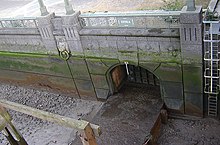The subterranean or underground rivers of London are or were the direct or indirect tributaries of the upper estuary of the Thames (the Tideway) that were built over during the growth of the metropolis of London. They now flow through culverts,[2] with some of them integral parts of London's sewerage system and diverted accordingly.[3]



North of the Thames
editFrom west to east - sub-tributaries are shown indented
- River Brent (partially underground)
- Stamford Brook
- Parrs Ditch
- Counter's Creek
- River Westbourne
- River Tyburn
- River Fleet, (following Farringdon Street, New Bridge Street and other roads).
- Lamb's Conduit
- Fagswell Brook (Follows the course of Charterhouse Street)
- River Walbrook
- Lorteburn[4] or Langbourne (now dry)
- Black Ditch
- Muswell Stream[5] (sub-sub-tributary via Pymmes Brook and the River Lea)
- River Moselle[5] (subtributary via the Lea)
- Hackney Brook (subtributary via the Lea)
- River Rom (partially underground)
South of the Thames
editFrom west to east - sub-tributaries are shown indented
- Sudbrook (partially underground)
- Beverley Brook (partially underground)
- Graveney (sub tributary of River Wandle)
- Falconbrook
- River Effra
- River Neckinger
- Earl's Sluice
- River Quaggy (partially underground) (sub tributary of River Ravensbourne)
- Heathwall Ditch[6]
Development
editIn June 2008, the office of Mayor of London published outline plans to reinstate some underground rivers.[7] In January 2009, a partnership among the Environment Agency, Natural England, The River Restoration Centre, and the Greater London Authority set out a strategy for putting this into effect by creating the London Rivers Action Plan.[8][9]
See also
edit- Blue Ribbon Network—the major waterways of London
- List of rivers of England
- Subterranean London
- Subterranean river
- Tributaries of the River Thames
References
edit- ^ Loftie, William John (1884). A History of London (2nd ed.). London: Edward Stanford.
- ^ Nicholas Barton, The Lost Rivers of London, Historical Publications, ISBN 0-948667-15-X
- ^ Humphreys, Sir George W. (November 1930). Main Drainage of London (PDF). London: London County Council. p. 5. Archived from the original on 2 May 2019. Retrieved 2 May 2019.
{{cite book}}: CS1 maint: unfit URL (link) - ^ Bentley, David (1984). "A recently identified valley in the City" (PDF). London Archaeologist. 05 (1): 13–16. Retrieved 27 December 2022.
- ^ a b London's Lost Rivers (2011) Paul Talling, Random House, pp148-150 ISBN 9781847945976
- ^ "The Lost River of London You've Never Heard Of: The Heathwall". Londonist.
- ^ "Boris Johnson to revive London's lost rivers". The Times. London, UK. 5 September 2008. Archived from the original on 5 September 2008.
- ^ "Environment Agency plans for river restoration". Environment-agency.gov.uk. UK. 2 March 2010. Archived from the original on 26 June 2009. Retrieved 25 July 2010.
- ^ "London Rivers Action Plan". UK: The River Restoration Centre. Archived from the original on 15 August 2009. Retrieved 25 July 2010.
Further reading
edit- Dangerfield, Andy (4 October 2015). "The lost rivers that lie beneath London". London, UK: BBC News.
- "The Underground City: Beneath the streets of London's capital city is a world of tunnels, rivers and hidden history". Heritage Magazine. April–May 2000. Archived from the original on 10 December 2002. Retrieved 10 December 2002.
{{cite news}}: CS1 maint: bot: original URL status unknown (link)
External links
edit- "Deep Topographical site with special emphasis on London's lost watercourses". Middlesex County, UK: Middlexex County Council.
- Mackie, Gordon (January 2004). "London's Lost Rivers: Wayback Machine Snapshot". Archived from the original on 7 January 2004.
{{cite web}}: CS1 maint: bot: original URL status unknown (link) - "Map of London's Underground Rivers". OpenGuides.org. London, UK.
- "Photographs from inside London's 'Lost' Rivers". SilentUK.com. Archived from the original on 10 September 2012.
{{cite web}}: CS1 maint: unfit URL (link) - "Strange Maps". London's Lost Rivers.